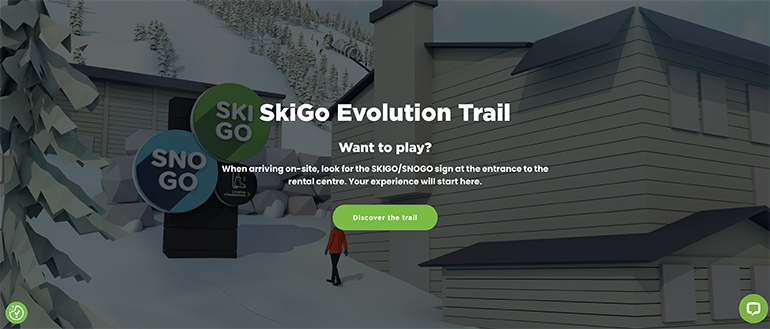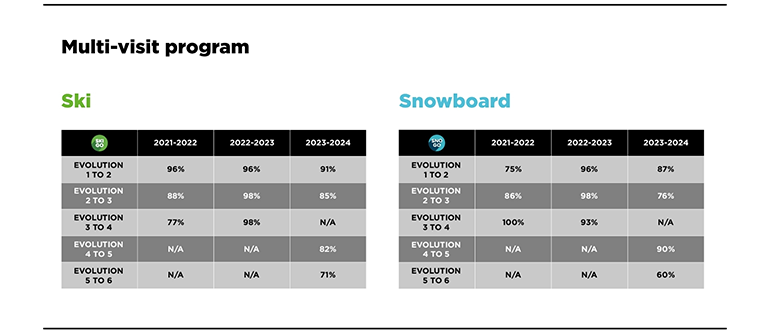Problems, roadblocks, curveballs, and hiccups happen. Ski area operators and managers deal with them every day, and hope that the speedbump of today will be minor. Sometimes, though, a ski area’s pressure points call for extensive thought, planning, and change. For situations like these, businesses require high-level problem-solving skills.
Most industries, and certainly our society, tend to focus on quick fixes. Design thinking changes the approach from finding quick fixes to arriving at broad solutions.
“Design thinking is a holistic approach into understanding what you need to do, where you need to go, and how you’re going to do it,” says Penny Paris, director of sports education at Ski Saint-Bruno in Quebec. It’s an approach that she and her team applied to solve the resort’s problem with its retention rate for beginner snowboarders.
It’s an approach that completely changed the beginner experience, created the resort’s innovative Evolution Trail, and increased the retention rate ten-fold.
Ski Saint-Bruno’s Challenge
Ski Saint-Bruno had been failing beginner snowboarders. “Our retention rate for beginning snowboarders was nine percent,” says Paris.
The obvious answer. Snowsports school instructors and leaders knew the main barrier facing students: they had to hike up to slide down on appropriate beginner terrain. Never one to shy away from a problem or a potential solution, Ski Saint-Bruno invested in a new conveyor lift. Without a doubt, the new surface lift improved the experience for snowboarding neophytes. The retention rate, however, remained at just 9 percent.
If the experience was better, why weren’t beginners returning for more?
The pause that refreshes. It is quite possible, says Paris, that if the leadership team at Ski Saint-Bruno had paused to study the problem more holistically, from multiple angles, and had approached the situation differently, they might have come up with a different solution than the conveyor lift—perhaps even one that accomplished their ultimate goal, which was improving the retention rate.
Since the new lift failed to improve retention, Paris worked with her colleagues on the Ski Saint-Bruno leadership team to study snowboarding at their mountain more broadly. (The approach was informed by Paris’s master’s degree in education, focused on critical thinking, and bachelor’s in art, where she developed her fundamentals in design.)Beginner retention turned out not to be a snowsports school issue (although who could be blamed for making this assumption?). Rather, it was a resort-wide issue.
Get in the customer’s shoes. To understand the problem, the team researched the beginner’s journey from first visiting the ski area’s website to being on the snow with lesson, ticket, and equipment in hand. The result was concerning. “The process included forty-five steps,” says Paris. “Through six departments.”
Everyone saw the need to streamline the process. And they wanted any changes, unlike the conveyor lift, to move the needle in a positive direction for retention. So they turned to the process of design thinking.
 To ensure positive beginner experiences, leaders at Ski Saint-Bruno, Quebec, studied the guest journey from start to finish, asking, does each step encourage people to return? Does it feel safe? Is it fun? The resulting Evolution Trail, developed over several years, has increased beginner retention ten-fold.
To ensure positive beginner experiences, leaders at Ski Saint-Bruno, Quebec, studied the guest journey from start to finish, asking, does each step encourage people to return? Does it feel safe? Is it fun? The resulting Evolution Trail, developed over several years, has increased beginner retention ten-fold.
Asking the Right Questions
At every step in a beginner’s journey, Paris and her colleagues asked basic questions: Does the step encourage people to want to return? Does it feel safe? Is it fun? Is it accessible? Is it easy? Is it positive?
“We always returned to, ‘Why are we doing this?’” she adds. “It wasn’t about solving problems; it was about ensuring that every step was human centered.”
Once the team established questions to explore and uncover what guests want and need, leaders then brainstormed ideas for accomplishing these ends. Paris calls this “ideation.” And it led to some important discoveries that shaped changes across the beginner journey.
Discovering what guests want. “We established that new students didn’t want to fall down in their lessons,” Paris says. Therefore, Ski Saint-Bruno experimented with regrading the pitches of beginner slopes, adding terrain-based learning, and adding even more conveyor lifts.
At every step, they watched for when students smiled—and when they did not.
They didn’t stop their investigation on the hill, of course. They also learned about what beginners looked for on the website, where they wanted to park, how they wanted to get their rentals, and how many stops they needed to make before they arrived at the snow front.
“At every step,” says Paris, “we asked, ‘What do the humans need?’”
Prototype. Test. Rinse. Repeat. Design thinking does not rush. It tests and circles back, tests and circles back. It works because it constantly refers to the central question: What does our guest need?
Diligence pays off. “It’s not a quick process,” says Paris of gathering data. And the process isn’t necessarily linear; some of the steps sometimes repeat. But it works. Over the course of several winters, the snowboarder study resulted in a complete overhaul of the physical plant, the website, and e-commerce; of the systems around getting tickets, rentals, and vouchers; and of the snowsports school’s teaching methodology.
On one hand, all this effort sounds daunting and laborious. On the other, “Our retention rate now is ninety-six percent,” Paris says.
 The two tables illustrate retention between visits within Saint-Bruno’s multi-visit programs. For example, from the first visit (Evolution 1) to the second (Evolution 2), 96 percent of ski participants returned in 2021-22. The retention from Evolution 2 to Evolution 3 was 88 percent, and so on, per season. Of note: Each year, the resort has seen a 30 to 40 percent increase in beginners in both the ski and ride programs.
The two tables illustrate retention between visits within Saint-Bruno’s multi-visit programs. For example, from the first visit (Evolution 1) to the second (Evolution 2), 96 percent of ski participants returned in 2021-22. The retention from Evolution 2 to Evolution 3 was 88 percent, and so on, per season. Of note: Each year, the resort has seen a 30 to 40 percent increase in beginners in both the ski and ride programs.
A Patient, Thoughtful Mindset
Beginner retention is just the sort of problem that design thinking is designed to solve. Designers—people who work in applied fields like industrial design, environmental architecture, graphic design, and engineering—approach problem solving and solution identification a bit differently than most. An architect or designer imagines options and opportunities and gathers data on possibilities, sticking points, and alternatives that could come as a result of the options. Eventually, they come to potential solutions.
On some level, many people employ parts of the design thinking process innately. But the total approach calls on problem-solvers to continually refer back to the problem they are trying to solve and the result they are trying to achieve. (For more details, see sidebar “Thoughts About Design Thinking,” p. 36.) The strategy can prove useful to resort operators and managers as they encounter, then resolve, the next friction point in their operations. Like, say, beginner snowboarder retention.
Identify the desired outcomes. Beyond the retention study, Paris cites the example of streamlining the guest service process of going through “claims” (the catch-all term Ski Saint-Bruno uses for any guest experience that needs follow-up, such as lost skis, complaints, kudos, etc.). A traditional approach would be to study the process and the tools used to gather claims, like QR codes and forms, and how the claims could get processed more quickly and efficiently.
A design thinking approach would ask instead: “What is our guest service goal?” says Paris. “We would ask about whether we fixed a problem, or provided an experience for our guest.”
It may turn out that the guest doesn’t necessarily care how fast or efficiently the claim gets processed. It may be that the guest wants immediate human interaction—acknowledgement or an apology—and resolution of the claim may be secondary.
To get to the real issues, the process of design thinking flips the traditional thinking. Instead of identifying the problems we want to solve, design thinking begins with identifying what outcomes we hope to achieve. The task then becomes figuring out how to get there.
 Left to right: Design thinking led Ski Saint-Bruno to focus on discovering what snowboard beginners want—such as a safe experience, and to not fall; Construction of Step 1 of the SKIGO/SNOGO Evolution Trail was a key development inspired by the design thinking process.
Left to right: Design thinking led Ski Saint-Bruno to focus on discovering what snowboard beginners want—such as a safe experience, and to not fall; Construction of Step 1 of the SKIGO/SNOGO Evolution Trail was a key development inspired by the design thinking process.
Reaching Desired Outcomes
Achieving desired outcomes—figuring out what we can do to make it possible (and affordable) to get there, and whether the outcome we’re driving toward is the correct destination—can be a years-long process.
What struck Paris during her experience with the snowboarder retention situation at Ski Saint-Bruno was the importance of resisting the urge to “fix” the problem. “Instead, we asked at every step: ‘Are we answering the basic need?’” she says.
Prototyping and testing take time. The prototyping and testing phases were most impactful for Paris. Ironically, she feels these may be the areas where results-driven and quick-fix-oriented managers may have the most resistance.
“It’s going to take time, and everybody has to be invested in the process,” Paris says.
Teams that approach problems and friction points with a design thinking mindset don’t rush to a quick fix. They ask questions, brainstorm ideas, prototype and test, and then tell the story of what they discovered.
An emphasis on how to influence outcomes and what creative solutions might look like—and then a willingness to put those ideas to the test to gather data—allows a team to ultimately land at an impactful solution that works.
The whole process leads to effective long-term solutions and staff and customer buy-in. And it does so by putting customers at the forefront.
Seek out the real issues. It’s important to think creatively and imagine how things can be better. If resort leadership had simply watched the bottom line on the learn-to program, for example, they wouldn’t have seen a problem. Because of increasing product prices, Paris says, her department was still meeting (and even exceeding) revenue targets. But digging into the human element underlying the revenue numbers uncovered the unsustainable and concerning retention trend.
Benefits extend resortwide. While design thinking produces good results for customers, it benefits the business, team, and individuals as well, encouraging and allowing employees to become more adaptable, creative, and effective in their roles.
And by the way: attempts and prototypes that don’t work are not failures. They are data.
Thoughts About Design Thinking
Design thinking provides a way for resorts to confront intractable, seemingly insolvable problems, from conversion and retention of beginners and younger generations to financing new lifts and other major infrastructure. So it’s worth understanding what’s involved.
“We live in a world of interlocking systems, where many of the problems we face are dynamic, multi-faceted, and inherently human,” says the website of IDEO, a design firm that established online courses (that it calls IDEO U) to share the value and methodology of the design thinking process.
IDEO U says design thinking “encourages organizations to focus on the people they’re creating for, which leads to better products, services, and processes.
“When you sit down to create a solution for a business need, the first question should always be, ‘What’s the human need behind it?’”
The steps, according to IDEO U, are:
- Frame a Question: Identify a driving question that inspires others to search for creative solutions.
- Gather Inspiration: Inspire new thinking by discovering what customers really need.
- Synthesize for Action: Make meaning out of diverse information to identify a strategic focus.
- Generate Ideas: Push past obvious solutions to get to breakthrough ideas.
- Make Ideas Tangible: Build rough prototypes to learn how to make ideas better.
- Test to Learn: Refine ideas by gathering feedback and experimenting forward.
- Share the Story: Craft a human story to inspire others toward action.





